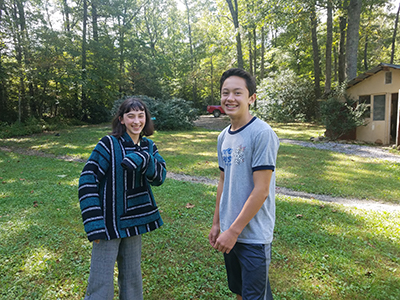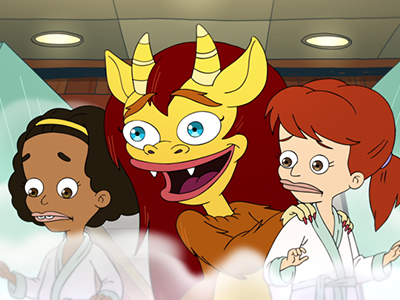Big Mouth Gives Insight on Puberty

Talking about puberty with a middle schooler is no easy task. When approached, their most common response is to hide their faces and call out, “Awkward!” Most of the time they just try to run away. It’s understandable. Experiencing major changes in their body and emotions is confusing. It’s normal for middle schoolers to feel embarrassed by their bodies and constantly compare themselves to their peers. In such an atmosphere, it’s not a surprise that students don’t want to openly talk about what’s going on with them.
Enter Big Mouth, an animated Netflix series about middle schoolers now in its second season. I don’t usually discuss TV shows on this blog. As a school committed to limiting our middle schooler’s exposure to media, TV is often eschewed for other educational tools. Big Mouth uses wildly inappropriate humor, so as a teacher I could never recommend it to a student. That said, I secretly hope that every middle schooler I know discovers this series on their own because Big Mouth gets it right!
Personifying Emotions
 Puberty can make a young adolescent feel crazy. The hormone surges, the sudden emotional outbursts that can come out of no where, their impulsivity: it can make even the most well adjusted middle schooler feel like a monster. And that is exactly how Big Mouth portrays puberty. The show uses an unwelcome Hormone Monster to personify many of the unwanted embarrassing thoughts and incontrollable impulses pubescent teens experience. As a middle schooler, I remember thinking there was a monster inside me a lot of time. I just never had a name for it.
Puberty can make a young adolescent feel crazy. The hormone surges, the sudden emotional outbursts that can come out of no where, their impulsivity: it can make even the most well adjusted middle schooler feel like a monster. And that is exactly how Big Mouth portrays puberty. The show uses an unwelcome Hormone Monster to personify many of the unwanted embarrassing thoughts and incontrollable impulses pubescent teens experience. As a middle schooler, I remember thinking there was a monster inside me a lot of time. I just never had a name for it.
Every student has their share of emotional outbursts and social mishaps in their time at Arthur Morgan School. In the aftermath of these moments, students typically feel bewildered by their behavior. I have heard more than one middle schooler express that they don’t know what came over them. Big Mouth‘s hormone monsters provide a language for discussing these moments.
The Shame Wizard
Another character in Big Mouth who appears in season two is the Shame Wizard. This phantom shows up every time someone makes a mistake, whispering shameful judgements into the ears of show’s middle schoolers. Often, the mistake was a choice made at the insistence of the hormone monster. It was this character that made me realize how brilliant the show truly is at depicting all the confusing messages teenagers are navigating. Middle schoolers are are filled with shame and many of their daily behaviors are either in response to or trying to prevent feeling embarrassed.
Two common strategies for dealing with this shame are to withdraw from friends or to lash out at peers. Either way, the feeling of shame prevents students from receiving support they need exactly when they are feeling the most vulnerable. Combating this toxic influence is at the core of what middle school teachers do daily.
Giving their Feeling a Name
For many middle schoolers, the first step to changing behaviors is understanding the feelings and impulses behind them. Giving them names is a great way to help young adolescents normalize their emotions and have compassion for themselves. They can see their actions as one possible response to their feelings, as opposed to a reflection on who they are as people. From there, they can understand that they have a choice about how to handle similar moments in the future.

Big Mouth, Netflix
Although I will never show any students Big Mouth, I do incorporate the show’s language. Recently, when talking to my own seventh grader, I found myself using the Hormone Monster and Shame Wizard to identify influences in his behavior. He appreciated the creative imagery to describe his feelings, and it gave us a language we can refer to repeatedly as he grows up.
Help Getting through Puberty
At AMS, social advisors and houseparents support the middle school students by providing guidance and empathy through difficult moments. Students also take Personal Growth class where they get information on a variety of topics: identity, drugs, conflict resolution, and puberty. Students ask questions and express emotions with staff and peers that they trust. In the same way that Big Mouth normalizes the teenage experience without being patronizing, so can the adults around them.
In the final episode of Big Mouth‘s second season, even more personifications were introduced. One middle school character was smothered by Depression Kitty, who represents the heaviness people suffering from depression often feel. They also gave hints about the existence of an Anxiety Armadillo and Ambition Gremlin. I am looking forward to seeing how these new creatures will influence the characters next season.
Eventually, middle schoolers outgrow the intensity of these impulses. We watch our middle schoolers change rapidly in their time at AMS. The differences between a seventh grader and a ninth grader in terms of maturity, social competency, and self-control is staggering. As our ninth graders graduate and transition into high school, they feel confident and capable of handling difficult emotions, all because they grew up in a compassionate and understanding community.
by Nicholas Maldonado and Kavita Hardy
